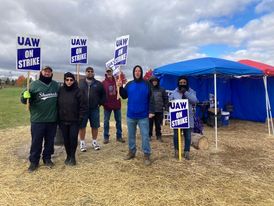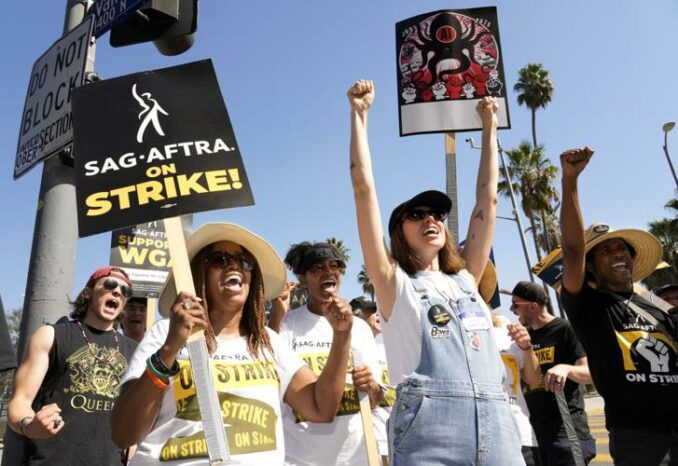Striketober 2023!

UAW picket line outside Stellantis parts distribution center, Streetsboro, Ohio, Oct. 22, 2023.
In 2021, the month of October was nicknamed “Striketober” because of an uptick in the number of striking workers that month. Included were thousands of union members at John Deere, Nabisco and Kellogg’s.
October 2023 would definitely qualify for the same nickname, even more so than October of two years ago. A strike spreadsheet shared in an Oct. 20 email from the AFL-CIO to its members showed over 90 picket lines in two dozen states involving hundreds of thousands of workers. A few of the strikes listed have actually been settled, with the strike weapon able to secure contracts the workers found satisfactory.
Currently, the biggest strike is by 160,000 members of Screen Actors Guild-American Federation of Television and Radio Actors, who marked 100 days on strike Oct. 21.
On Day 95, union members crashed a celebration of Disney’s 100-year anniversary. The next day, Oct. 17, the union had a Pride celebration which, in addition to pushing the strike demands, called for an end to misrepresentation of the trans community by the entertainment industry.
SAG-AFTRA members are fighting for job security — which is threatened if the studios expand the use of artificial intelligence — a wage increase and higher residuals. “Residuals are additional compensation paid to performers when a production is shown beyond the original use covered by the initial compensation,” SAG-AFTRA explains on its web site.
It took the Writers Guild of America 160 days on the picket line to win a contract from the same studios SAG-AFTRA is striking. The WGA announced Oct. 9 that 99% of its members voted to ratify the agreement.

SAG-AFTRA strikers outside Netflix in Los Angeles, Oct. 17, 2023.
UAW hits ‘corporate greed’
The history-making strike of the United Auto Workers against all three U.S. auto companies entered its fifth week Oct. 20. There are currently 46,000 workers on strike out of 140,000 who work for Ford, General Motors and Stellantis. The latest to be struck are two highly profitable plants: Stellantis Sterling Heights Assembly Plant near Detroit, whose 6,800 workers walked out Oct. 23 and GM’s Arlington, Texas, plant whose 5000 workers struck a day later. The UAW has put the Detroit Big Three on notice that more union members will walk out if called upon to do so.
The strike has moved all three companies from their initial offer of a 9% raise over four years to 23%, and full or partial restoration of the cost-of-living allowance that workers lost during the 2009 GM and Chrysler (now part of Stellantis) bankruptcies.
There has been progress in other areas, such as winning the right to strike over plant closings, but the UAW wants to see further movement before agreeing to a contract for the membership to vote on.
Hitting the companies for exorbitant profits, CEO salaries and shareholder compensation, UAW President Shawn Fain has pointed out that labor costs are only 4%-5% of the cost of a vehicle. “We’re not the problem,” he explained in a video in September. “Corporate greed is the problem.” (UAW International Union on Facebook)
The UAW is fighting the capitalists on many fronts. Blue Cross Blue Shield (BCBS) of Michigan employees began their strike shortly before the Big Three strike. Workers at Westrock Packaging, Dometic, Mack Trucks and CVR Nitrogen are out. At Thombert and at an Infiniti dealership, striking UAW members have won and ratified contracts.
UAW-represented workers at Detroit’s three casinos, along with workers represented by UNITE-HERE, the Teamsters, the Operating Engineers and the Carpenters unions, struck together on Oct. 17.
On Oct. 19 strikers from the Big Three, BCBS and the casinos held a united, militant “March for Workers’ Rights and Economic Justice.”
Health care workers demand safe staffing
At 6 a.m. on October 4, the biggest health care strike in U.S. labor history began as 75,000 members of the Coalition of Kaiser Permanente Unions took to the picket line in multiple states. The Coalition is composed of 11 local unions of the Service Employees Union (SEIU), Office and Professional Employees International Union (OPEIU) and the International Federation of Professional and Technical Engineers (IFPTE). There may be another strike beginning Nov. 1 of Kaiser workers in Oregon and southern Washington, whose contract expires Oct. 31
The three-day Unfair Labor Practice strike was in response to Kaiser Permanente’s repeated “bad faith bargaining” when it failed to respond to union proposals on a range of issues.
One of the main issues for healthcare workers is staffing levels. As the for-profit healthcare industry cuts jobs to levels below the bare minimum, workers are forced to strike, not only for their well-being but that of their patients.
As the Coalition of Kaiser Permanente Unions states on its web site, “As frontline healthcare workers, we got into this work to help people. It’s frustrating and painful to watch our patients waiting and suffering while we burn ourselves out trying to do the work of two or even three people trying to care for everyone.” (unioncoalition.org)
The strike was enough to get the company to agree to a contract, which members of all three unions approved by a wide margin, that addressed staffing concerns as well as providing a significant wage increase.
However, nurses at the Robert Wood Johnson University Hospital in New Brunswick, New Jersey, are still fighting for safe staffing. Their strike began Aug. 4.
Rounding out the Striketober picture are hotel workers, auto mechanics, newspaper workers, performers, teachers and others. Their militancy is part of a trend that began with successful organizing drives and strikes by graduate student workers and workers at Starbucks, Amazon, Trader Joes, REI, and other big corporations.

